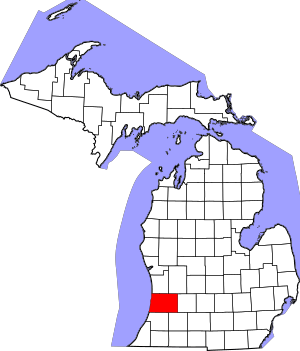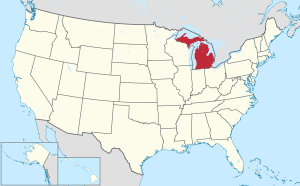Allegan County, Michigan facts for kids
Quick facts for kids
Allegan County
|
|
|---|---|

Location within the U.S. state of Michigan
|
|
 Michigan's location within the U.S. |
|
| Country | |
| State | |
| Founded | established 1831 organized 1835 |
| Seat | Allegan |
| Largest city | Holland |
| Area | |
| • Total | 1,833 sq mi (4,750 km2) |
| • Land | 825 sq mi (2,140 km2) |
| • Water | 1,008 sq mi (2,610 km2) 55%% |
| Population
(2020)
|
|
| • Total | 120,502 |
| • Estimate
(2023)
|
121,939 |
| • Density | 65.740/sq mi (25.382/km2) |
| Time zone | UTC−5 (Eastern) |
| • Summer (DST) | UTC−4 (EDT) |
| Congressional district | 4th |
| Website | http://www.allegancounty.org |
Allegan County (/ˈæləɡən/ al-Ə-gən) is a county in the U.S. state of Michigan. As of the 2020 United States Census, the population was 120,502. The county seat is Allegan. The name was coined by Henry Rowe Schoolcraft to sound like a Native American word. Allegan County comprises the Holland, Michigan Micropolitan Statistical Area, which is included in the Grand Rapids–Kentwood–Muskegon Combined Statistical Area. It is primarily an agricultural area that is rapidly becoming urbanized as the population centers of Grand Rapids on the northeast and Kalamazoo to the southeast expand into Allegan County.
The county has long been a regional tourist draw, particularly the Tulip Time Festival in Holland and the area along Lake Michigan. The Lake Michigan shoreline has long been a popular place for vacation homes, and that development continues, especially around Saugatuck and Douglas. Another draw is Allegan State Game Area, a 45,000 acres (180 km2) forest attracting campers, snowmobilers, cross-country skiers and hunters. Allegan County contains Saugatuck Dunes State Park with trails through scenic dunes and a swimming beach on Lake Michigan. The county also contains Pier Cove Park, a public beach with Lake Michigan access. Lake Allegan is a popular destination.
Contents
History
The Michigan peninsula was long occupied by bands of the Pottawatomi and Ojibwe of the Lake Superior Band of Chippewa Indians. The United States government forced the tribes to cede their extensive territories to the federal government, in exchange for annuities and small reservations. The federally recognized Match-e-be-nash-she-wish Band of Pottawatomi has a reservation here.
The boundaries of Allegan County were laid out by the Territorial legislature in 1831. The county was organized in 1835. At that time there were only about four European-American families in the area. Among the first settlers of Allegan County were Giles Scott and Turner Aldrich.
Geography
According to the US Census Bureau, the county has a total area of 1,833 sq mi (4,750 km2), of which 825 sq mi (2,140 km2) is land and 1,008 sq mi (2,610 km2) (55%) is water.
Adjacent counties
By land
- Ottawa County – north
- Kent County – northeast
- Barry County – east
- Kalamazoo County – southeast
- Van Buren County – south
By water
- Lake County, Illinois – southwest
- Kenosha County, Wisconsin – west
- Racine County, Wisconsin – northwest
Transportation
Major highways
 I-196
I-196 BL I-196
BL I-196 US 31
US 31
 Bus. US 31
Bus. US 31 US 131
US 131 M-40
M-40 M-89
M-89- M-179
- M-222
 A-2
A-2 A-37
A-37 A-42
A-42 A-45
A-45
Demographics
| Historical population | |||
|---|---|---|---|
| Census | Pop. | %± | |
| 1840 | 1,783 | — | |
| 1850 | 5,125 | 187.4% | |
| 1860 | 16,087 | 213.9% | |
| 1870 | 32,105 | 99.6% | |
| 1880 | 37,815 | 17.8% | |
| 1890 | 38,961 | 3.0% | |
| 1900 | 38,812 | −0.4% | |
| 1910 | 39,819 | 2.6% | |
| 1920 | 37,540 | −5.7% | |
| 1930 | 38,974 | 3.8% | |
| 1940 | 41,839 | 7.4% | |
| 1950 | 47,493 | 13.5% | |
| 1960 | 57,729 | 21.6% | |
| 1970 | 66,575 | 15.3% | |
| 1980 | 81,555 | 22.5% | |
| 1990 | 90,509 | 11.0% | |
| 2000 | 105,665 | 16.7% | |
| 2010 | 111,408 | 5.4% | |
| 2020 | 120,502 | 8.2% | |
| 2023 (est.) | 121,939 | 9.5% | |
| US Decennial Census 1790–1960 1900–1990 1990–2000 2010–2019 |
|||
As of the 2010 United States Census, there were 111,408 people living in the county. 92.9% were White, 1.2% Black or African American, 0.6% Asian, 0.6% Native American, 2.8% of some other race and 1.9% of two or more races. 6.7% were Hispanic or Latino (of any race). 23.0% were of Dutch, 17.5% German, 8.3% English, 7.1% Irish and 7.1% American ancestry.
As of the 2000 United States Census, there were 105,665 people, 38,165 households, and 28,394 families living in the county. The population density was 128 inhabitants per square mile (49/km2). There were 43,292 housing units at an average density of 52 per square mile (20/km2). The racial makeup of the county was 93.47% White, 1.31% Black or African American, 0.55% Native American, 0.55% Asian, 0.03% Pacific Islander, 2.77% from other races, and 1.32% from two or more races. 5.72% of the population were Hispanic or Latino of any race. 25.6% were of Dutch, 17.8% German, 9.6% American, 8.4% English and 7.2% Irish ancestry, 93.6% spoke only English; 5.2% spoke Spanish at home.
There were 38,165 households, out of which 37.40% had children under the age of 18 living with them, 61.40% were married couples living together, 9.10% had a female householder with no husband present, and 25.60% were non-families. 20.70% of all households were made up of individuals, and 7.80% had someone living alone who was 65 years of age or older. The average household size was 2.72 and the average family size was 3.15.
The county population contained 28.90% under the age of 18, 8.00% from 18 to 24, 30.00% from 25 to 44, 22.00% from 45 to 64, and 11.10% who were 65 years of age or older. The median age was 35 years. For every 100 females, there were 99.60 males. For every 100 females age 18 and over, there were 97.60 males.
The median income for a household in the county was $45,813, and the median income for a family was $51,908. Males had a median income of $38,681 versus $26,887 for females. The per capita income for the county was $19,918. About 5.00% of families and 7.30% of the population were below the poverty line, including 7.50% of those under age 18 and 7.90% of those age 65 or over.
Religion
- The Reformed Church in America was the largest Protestant denomination with 4,500 members in 11 churches.
- The United Methodist Church was second, with 3,600 congregants in 20 churches.
- The Christian Reformed Church was third, with 10 churches and 2,600 members.
- The Catholic Church has 10,000 members as of 2010[update].
- The Church of Jesus Christ of Latter-day Saints has one meetinghouse.
Arts and Culture
Allegan County is part of the annual Arts and Eats tour, which highlights local art, food, and farms.
Communities
Cities
Villages
Unincorporated communities
- Argenta
- Bakersville
- Beachmont
- Bentheim
- Belknap
- Bradley
- Bravo
- Boyd
- Burnips
- Castle Park
- Cedar Bluff
- Cheshire
- Chicora
- Corning
- Diamond Springs
- Dorr
- Dunningville
- East Saugatuck
- East Martin
- Fillmore
- Ganges
- Glenn
- Glenn Haven Shores
- Glenn Shores
- Graafschap
- Grange Corners
- Green Lake
- Hamilton
- Hawkhead
- Hilliards
- Hooper
- Hopkinsburg
- Kibbie
- Lacota
- Lee
- Leisure
- Macatawa
- Macks Landing
- Merson
- Miami Park
- Millgrove
- Moline
- Monteith Station
- Monterey
- Monterey Center
- Mount Pleasant
- Neeley
- New Salem
- New Richmond
- Old Saugatuck
- Old Squaw Skin Landing
- Overisel
- Oxbow
- Pearl
- Pier Cove
- Plummerville
- Pullman
- Sandy Pines
- Shelbyville
- Sherman Park
- Shorecrest
- Shorewood
- South Haven Highlands
- South Monterey
- Spring Grove
- Sulphur Springs
- Watson
Townships
- Allegan Township
- Casco Township
- Cheshire Township
- Clyde Township
- Dorr Township
- Fillmore Township
- Ganges Township
- Gun Plain Charter Township
- Heath Township
- Hopkins Township
- Laketown Township
- Lee Township
- Leighton Township
- Manlius Township
- Martin Township
- Monterey Township
- Otsego Township
- Overisel Township
- Salem Township
- Saugatuck Township
- Trowbridge Township
- Valley Township
- Watson Township
- Wayland Township
See also
 In Spanish: Condado de Allegan para niños
In Spanish: Condado de Allegan para niños

